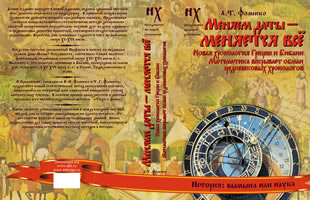Publishing house AST, 2011.
CONTENTS
Chapter 1. "ANTIQUE" GREECE IS A REFLECTION OF THE MEDIEVAL GREECE OF THE XII-XVI CENTURIES WITH A CHRONOLOGICAL SHIFT ON 1800 YEARS AND MORE.
1. Greek and Biblical chronology.
2. A legend about offence of a woman (religion?).
3. The great "antique" Greek colonization – these are the medieval Crusades.
4. The epoch of tyrants.
5. Again the Trojan war of the XIII century A.D. in the description of Herodotus. Medieval Charles d'Anjou – this is Persian tsar Cyrus.
6. Medieval traces of "antique" Homer in the XIII-XIV centuries. A famous medieval family of Saint-Omers = Saint Homer.
7. A famous abduction of the Sabine women in "antique" Rome and carve-up of wives and daughters in Greece of the beginning of the XIV century A.D. Foundation of Rome in Latinia, and then Italian Rome in the XIV century A.D.
8. Medieval Charles de Naples – it is "antique" tsar Cambyses.
9. Medieval Friedrich Sicilian – it is "antique" tsar Darius.
10. Medieval Margaret – it is "antique" Mardunya.
11. Medieval Matilda – it is "antique" Miltiades.
12. Medieval duke Walter – it is "antique" Xerxes the Great.
13. Medieval 300 knights of duke Jean La-Roche – these are famous "antique" 300 Spartans of tsar Leonid.
14. Medieval Greek war of 1374-1387 – it is "antique" Peloponnesian war.
15. When the famous Parthenon was built and why it is called a church of Virgin Mary.
16. Medieval Hemist Pletho - it is "antique" Plato.
17. Medieval despotate of Mistra - it is "antique" Sparta.
18. Turkish Osman Empire - it is "antique" Macedonia. Sultan Mohammed II - it is "antique" Philipp II.
19. The medieval siege of Constantinople-Byzantium - it is "antique" siege of Byzantium.
20. The end of Byzantium in the XV century A.D. – it is the end of "classical" Greece allegedly in the IV century B.C.
21. Surprisingly similar graphs of the volumes of the "antique" and medieval Greek "biographies".
Chapter 2. OVERLAPPING OF THE BIBLE ON PHANTOM AND REAL EUROPEAN-ASIAN EVENTS OF THE MIDDLE AGES WITH A SHIFT ON 1800 YEARS AND MORE.
0. Introduction.
1. Adam and Eve, expulsion from the Paradise.
2. Cain and Abel, murder of Abel, separation of the mankind on two folks.
3. Depravity of the mankind, the punishment is flood, patriarch Noah, ark, testament-rainbow.
4. Posterity of the sons of Noah: Shem, Ham and Japhet.
5. The confusion of Babylon, mixing of languages, dispersion of the folks.
6. Descendants of Shem until Terah.
7. Beginning of the activity of Abram. Struggle against pharaoh, exodus from Egypt.
8. Abram and Haran, separation for two kingdoms, Isaac, Esau, James, Judah, Joseph.
9. Joseph, Moses, struggle against pharaoh, exodus from Egypt, death of the troops of pharaoh.
10. Journeys of Israelites and conquest of the land of the Covenant.
10*. Identification of Joshua Ben Nun with Charles the Great. A medieval "Song about Roland" tells about the wars of the XV-XVI centuries A.D., described in the Bible as the wars of Joshua Ben Nun. Stopped Sun.
11. The epoch of Israelite Judges.
12. Further events of the epoch of Israelite Judges.
13. Books of Kingdoms.
14. A history of the Judaic kingdom.
15. The end of the Judaic kingdom and the Babylon captivity of the Jews were moved by chronologists to the deep past.
16. Babylon captivity according to the Bible, reflected as the Avignon captivity in the medieval chronicles allegedly of Italian Rome and France.
17. Why the era of Hegira is counted from the VII century A.D.
18. About the Biblical books 1-4 Kingdoms and 1-2 Chronicles.
Chapter 3. CORRELATION OF THE VOLUMES OF CHRONICLES AND DISCOVER OF CHRONOLOGICAL SHIFT FOR 300-400 YEARS IN THE RUSSIAN HISTORY.
1. Functions of the volumes of historical texts and the principle of amplitude correlation.
2. The principle of correlation of maximum on the material of the sources about the Time of Troubles in the history of Russia of 1584-1619.
Chapter 4. LITERARY AND ARCHEOLOGICAL FALSIFICATIONS.
1. Literary fakes.
2. Archeological fakes.
3. Demolition by Romanovs of Russian-Horde history on example of Cyril of White Lake monastery.
4. When Niccolo Machiavelli lived and actually what about he was writing in "The Prince".
Appendix 1. METHODS OF IDENTIFICATION OF "DISORDER" OF ACCIDENTIAL PROCESSES AND THEIR APPLICATION FOR THE ANALYSE OF HISTORICAL TEXTS.
Appendix 2. IDENTIFICATION OF HOMOGENEOUS AND NON-HOMOGENEOUS FRAGMENTS INSIDE RUSSIAN CHRONICLES, ROMAN AND GREEK MEMORIES, IN THE BIBLE.
1. Introduction.
2. Disorders in Russian chronicles.
3. Disorders in the work of Titus Livius and the work of Baronius.
4. Disorders in "The History" of Herodotus and in "The History" of Tacitus.
5. Disorders in the Bible.
Appendix 3. AUTHOR'S INVARIANT OF RUSSIAN LITERAL TEXTS. APPENDIX: WHO WAS THE AUTHOR OF "QUIET DON"? - V.P.Fomenko, �.G.Fomenko.
1. Introduction. Short history of the problem.
2. What is author's invariant.
3. Our approach. Selections, steps, evolution of the parameter along the text.
4. Doing an experiment. A list of studied by us parameters.
5. A list of studied by us authors and their works.
6. Calculation experiment.
7. Results of the experiment.
8. A frequency of use of functional words turns out to be an author's invariant.
9. Numerical examples.
10. How the discovered author's invariant could be applied. Possible discovering of plagiary.
11. Statistical analysis of the art of M.A.Sholokhov. Author's invariant of "Quiet Don" sharply differs from the author's invariant of the other works of �.�.Sholokhov.
12. Indirect observations – chronology and the volume of editions of M.A.Sholokhov.
13. Analysis of some texts of F.D.Kryukov.
14. A detailed table of distribution of functional words in the texts of M.A.Sholokhov.
Literature to Appendix 3.
Appendix 4. REPLIES ON NEW CHRONOLOGY. - A.T.FOMENKO, G.V.Nosovskiy.
Table DOP.2.1 (to Appendix 2). DISTRIBUTION OF THE VOLUMES OF CHAPTERS IN "THE HISTORY" OF HERODOTUS. - A.T.FOMENKO.
Table DOP.2.2 (to Appendix 2). DISTRIBUTION OF THE VOLUMES OF STANDARD, CANONICAL CHAPTERS OF THE BIBLE. - A.T.FOMENKO, G.V.Nosovskiy.
LITERATURE
